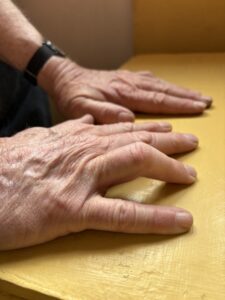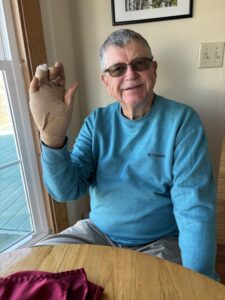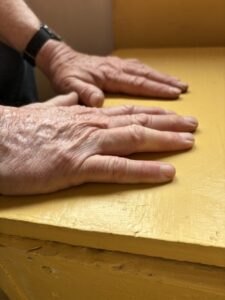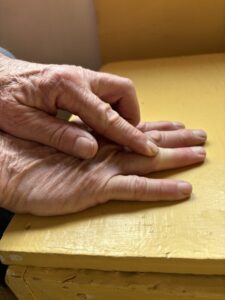Dupuytren’s Contracture: The Curse of the Vikings! Usually, we blog about nature and yards at Winding Pathways, but once in a while, we digress. This one’s about Rich’s Dupuytren’s adventure. But it is related to nature, as putting on gloves and manipulating his hand was becoming more difficult as two of his fingers began to curl. Also, genetics is nature.
Dupuytren’s Contracture is fairly common. It runs in families. The fingers on Rich’s Dad, Henry Patterson, curled so severely that manipulating tools, knobs, buttons, and eating utensils became difficult despite two surgeries to correct the condition.
Curse of the Vikings
So, what is it? Dupuytren’s Contracture was named for a French surgeon who described it first. It’s most common in men with Northern European ancestry, especially from Scandinavia and Scotland. That fits. Rich’s ancestors were from Denmark and Germany.

It’s caused when a knot of fascia forms under the skin usually in the palms beneath the ring finger and pinky. Sometimes a hard cord of material grows up the finger, forcing it to curl downward. Eventually, the finger can curl to about 90 degrees from the palm.
Women can get the condition, but less frequently than men, and often it’s not as severe.
Watchful
Rich first noticed a knot in his palm when he was 55 years old and gradually two of his fingers began to curl, making it impossible for them to lay flat on a table. There’s no way to predict whether Dupuytren’s will continue to grow or ever become a problem.
For many years Rich’s hand functioned normally with a slightly curved ring finger.
Doing Something About This
About two years ago he visited Dr. Clifford Novak, a hand surgeon at Cedar Rapids’ Physicians Clinic of Iowa. He encouraged Rich to return if the condition worsened or interfered with everyday activities. It started to, so in mid-2023 he again visited Dr. Novak and learned of three possible treatments: surgery to remove the material, needle aponeurotomy to cut the long cord causing the curl, and chemical treatment.
Because his condition was not profound and recovery sounded the easiest, he chose the needle method.
Surgery

The hand was bandaged for four days.
On February 23, 2023, Dr. Novak performed the surgery. Rich stayed in the outpatient Surgery Center for just four hours. He left with his hand heavily bandaged, making typing and any other form of manipulation difficult….but for only four days. On February 27th a physical therapist removed the bandages and gave Rich a series of exercises to help straighten the finger. Amazingly there were no sores or scars where the needles were inserted. For the first time in several years, he could lay all his fingers flat on a table. There was no pain. The result is amazing.
Follow-Up
There’s no assurance the Dupuytren won’t grow back in the same finger or progress in other fingers, but the surgery was so successful it could be repeated if needed.
Dr. Novak’s advice was to treat the curled finger BEFORE it became difficult to use.
Rich did this with success as these after photos reveal.
- Improved straightened finger.
- Exercises are simple and critical to recovering use of the finger.




Susan and I are happy to hear the good news since she, too, suffers from the same condition. Thank you for sharing. We well remember your dad’s suffering from the same accursed genetic condition.
Thanks, Richard. Techniques are vastly improved thanks to research and technology.